
Essential DIY Kit for Home Energy Independence
Share
You're taking the first step towards home energy independence by recognizing the significance of a well-equipped DIY kit, which can help you reduce your reliance on the grid, lower your electricity bills, and minimize your carbon footprint. A solid DIY kit should include essential components like a deep cycle battery bank, charge controller, inverter, monitoring system, and electrical panel. You'll also need to take into account solar panel types, battery selection, and inverter options. As you maneuver through the process, it's vital to prioritize energy efficiency, safety, and cost-effectiveness. Now that you've got the basics covered, it's time to explore deeper into the specifics that'll help you achieve energy independence.
Key Takeaways
- Prioritize finding a DIY kit that aligns with specific energy needs and goals, considering factors like solar panel quality and inverter efficiency.
- Essential components for small homes include a deep cycle battery bank, charge controller, inverter, monitoring system, and electrical panel.
- Proper installation of solar panels involves secure mounting, wiring, and obtaining necessary permits from local authorities.
- Choose the right battery capacity by calculating daily energy consumption and oversizing by 10-20% for unexpected demands.
- Regular monitoring and maintenance are crucial for system performance and efficiency, including cleaning solar panels and checking connections.
Understanding Solar Power Basics
Utilizing the power of sunlight, a boundless energy source, is a crucial step towards achieving home energy independence.
You'll leverage solar energy benefits, such as reduced electricity bills and a lower carbon footprint.
However, it's important to dispel common solar power myths that may be holding you back. One common misconception is that solar panels don't work during cloudy or rainy days, but they can still generate energy, albeit at a lower capacity.
Another myth is that solar panels are too expensive, but with decreasing costs and increasing efficiency, they're becoming a more viable option.
In fact, cost-effective solutions can reduce upfront costs and installation expenses, making solar energy more accessible.
Choosing the Right DIY Kit
When selecting a DIY kit for your home energy independence project, your top priority is finding a solution that aligns with your specific needs and goals.
You'll want to reflect on the solar kit features that matter most to you, such as the type and quality of solar panels, the inverter's efficiency, and the mounting system's durability.
Think about the energy independence benefits you're looking to achieve, like reducing your reliance on the grid or saving on your energy bills.
Many kits, including those from WindyNation, offer high-efficiency solar panels with up to a 20% efficiency rate for ideal performance.
Assess your energy usage patterns and determine the kit's capacity requirements.
Research and compare different kits, reading reviews and evaluating warranties.
Essential Components for Small Homes
Now that you've selected a DIY kit that meets your specific needs, it's time to focus on the components that will make your small home energy independent. For off-grid systems, energy efficiency is key. You'll need a deep cycle battery bank to store excess energy generated by your solar panels or wind turbines. A charge controller guarantees your batteries are charged safely and efficiently. An inverter converts DC power to AC for your home's appliances. A monitoring system helps you track your energy production and consumption.
| Component | Function |
|---|---|
| Deep Cycle Battery Bank | Stores excess energy for later use |
| Charge Controller | Regulates energy flow to batteries |
| Inverter | Converts DC to AC power for home use |
| Monitoring System | Tracks energy production and consumption |
| Electrical Panel | Distributes power to your home's appliances |
Setting Up Your Solar Panel
Your solar panel array is the backbone of your DIY kit, converting sunlight into electrical energy to power your small home.
When selecting solar panels, you'll need to choose between monocrystalline, polycrystalline, and thin-film solar panel types, each with its own efficiency and cost trade-offs. High-efficiency solar panels from brands like SunPower, Panasonic, and LG are recommended for peak performance, as they greatly influence system performance and longevity high-efficiency solar panels.
Before installation, verify you've obtained the necessary installation permits from your local authorities. A south-facing roof with minimal shading is ideal for maximum energy production.
Mount the panels securely, guaranteeing a watertight seal to protect against weathering. Connect the panels in series and parallel to achieve the desired voltage and current output.
Properly wire and ground the system to prevent electrical hazards.
Battery Selection and Installation
When selecting batteries for your DIY home energy independence kit, you'll need to evaluate the type of battery that best suits your needs, whether it's lead-acid, lithium-ion, or another option.
You'll also need to determine the right capacity for your system, considering your energy usage and storage goals.
As you prepare to install your batteries, keep in mind the importance of following safety guidelines to guarantee a safe and efficient setup.
Battery Type Options
Freedom from the grid beckons, and the right battery type is crucial to attaining it. When selecting a battery, you'll encounter two primary options: lithium-ion and lead-acid.
Lithium-ion batteries offer several advantages, including a longer lifespan (up to 15 years) and higher capacity ratings. They're also more eco-friendly and require less maintenance. However, they come at a higher cost.
Lead-acid batteries, on the other hand, are more affordable but have several drawbacks, including a shorter lifespan (around 5-7 years) and lower capacity ratings.
When choosing a battery, consider installation considerations, cost comparisons, and performance metrics. You'll also need to think about charging cycles and maintenance practices to guarantee peak performance.
Choosing Right Capacity
Since you've selected the right battery type, it's essential to determine the correct capacity for your energy independence needs. Capacity estimation is vital to guarantee you have enough energy storage to meet your consumption demands. To estimate the required capacity, calculate your daily energy consumption in watt-hours (Wh). Consider the appliances you want to power, their wattage, and the number of hours they'll be used.
| Appliance | Wattage (W) | Daily Usage (h) | Daily Energy (Wh) |
|---|---|---|---|
| Fridge | 150 | 8 | 1200 |
| Lights | 20 | 10 | 200 |
| Laptop | 65 | 4 | 260 |
Based on your calculations, choose a battery with a capacity that can cover your daily energy needs. Remember to oversize your battery by 10-20% to account for unexpected energy demands.
Installation Safety Tips
About 90% of DIY energy independence projects face safety issues due to improper battery installation and selection. When you're handling batteries, it's essential to prioritize safety.
Wear personal protective gear, including gloves and safety glasses, to prevent injuries. Make sure you're familiar with electrical codes and follow installation guidelines to avoid electrical shocks.
Conduct a risk assessment to identify potential hazards and develop emergency procedures. Invest in the right tool requirements, such as multimeters and wire strippers, to guarantee safe practices.
Don't compromise on safety gear – it's better to be safe than sorry. By following these guidelines, you'll greatly reduce the risk of accidents and guarantee a successful DIY energy independence project.
Inverter and Mounting Options
Your inverter choice plays an essential role in converting DC power from your solar panels or wind turbines into usable AC power for your home.
You'll need to decide between string inverters, microinverters, and power optimizers, each with their own benefits and drawbacks. String inverters are the most common type, but microinverters offer more flexibility and monitoring capabilities. Power optimizers provide a compromise between the two.
When it comes to mounting, you'll need to choose between roof-mounted, ground-mounted, and tracking systems. Roof-mounted systems are the most popular, but ground-mounted systems offer more flexibility. Tracking systems, which follow the sun's movement, can increase energy production by up to 45%.
Consider your specific needs and budget when selecting an inverter and mounting style.
Monitoring and Maintenance Tips
With your inverter and mounting style in place, it's time to focus on guaranteeing your system operates efficiently and effectively over the long haul.
You'll want to monitor your energy consumption regularly to identify areas for improvement. Check your system's performance data to confirm it's meeting your energy needs. Look for signs of decreased system efficiency, such as reduced power output or increased energy bills.
Regularly inspect your panels for dirt, debris, or damage, and clean them as needed. Also, perform routine maintenance tasks, like checking and replacing worn-out components, to prevent system downtime.
Frequently Asked Questions
How Do I Ensure My DIY Kit Complies With Local Building Codes?
You ascertain compliance by researching local regulations, reviewing safety standards, and consulting with authorities to confirm your DIY kit meets specific requirements, avoiding costly revisions and potential safety hazards.
Can I Use My Existing Electrical Panel With Solar Power?
You'll need to check your existing electrical panel's compatibility with solar power, considering its age, capacity, and condition. Upgrades might be required to guarantee safe and efficient integration, so consult a licensed electrician to determine the necessary electrical panel upgrades for solar panel compatibility.
Will Solar Power Work During a Blackout or Grid Outage?
You'll need solar battery storage to keep the lights on during a blackout or grid outage; with off-grid systems, you'll have power when the grid goes down, but without storage, your solar power won't work during an outage.
Do I Need to Clean My Solar Panels Regularly?
You'll want to clean your solar panels regularly to maintain efficiency; neglecting solar panel maintenance can lead to energy loss. Use gentle cleaning methods like soft brushes, distilled water, and mild soap to remove debris and guarantee peak performance.
Can I Expand My DIY Kit if My Energy Needs Increase?
Just like upgrading your smartphone, you'll want to future-proof your energy setup. If your energy needs increase, you can expand your DIY kit with energy upgrades, seamlessly integrating new components to meet growing demands, ensuring a reliable and efficient power supply.
Related Posts
-

Renewable Energy Solutions to Reduce Your Carbon Footprint
To reduce your carbon footprint, adopting renewable energy solutions is key. Using solar panels or wind turbines can ...
-

Advantages of Solar Generating Systems Over Traditional Energy
Solar generating systems provide several key advantages over traditional energy sources. You'll experience lower long...
-

Cost of Home Solar Battery
You're looking to invest in a home solar battery to reduce your grid reliance, but you're curious about the cost. The...


